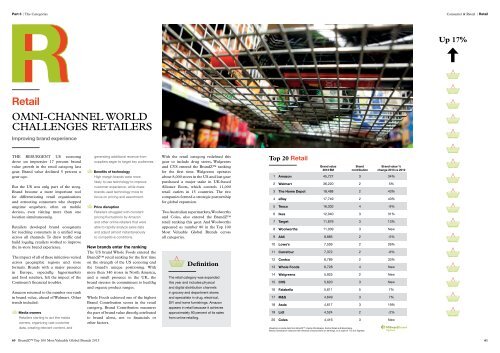Brand value increases across categories
Brand value increases across categories
Brand value increases across categories
Create successful ePaper yourself
Turn your PDF publications into a flip-book with our unique Google optimized e-Paper software.
Part 3 | The Categories<br />
Retail<br />
OMNI-CHANNEL WORLD<br />
CHALLENGES RETAILERS<br />
Improving brand experience<br />
THE RESURGENT US economy<br />
drove an impressive 17 percent brand<br />
<strong>value</strong> growth in the retail category last<br />
year. <strong>Brand</strong> <strong>value</strong> declined 5 percent a<br />
year ago.<br />
But the US was only part of the story.<br />
<strong>Brand</strong> became a more important tool<br />
for differentiating retail organizations<br />
and attracting consumers who shopped<br />
anytime anywhere, often on mobile<br />
devices, even visiting more than one<br />
location simultaneously.<br />
Retailers developed brand ecosystems<br />
for reaching consumers in a unified way<br />
<strong>across</strong> all channels. To draw traffic and<br />
build loyalty, retailers worked to improve<br />
the in-store brand experience.<br />
The impact of all of these initiatives varied<br />
<strong>across</strong> geographic regions and store<br />
formats. <strong>Brand</strong>s with a major presence<br />
in Europe, especially hypermarkets<br />
and food retailers, felt the impact of the<br />
Continent’s financial troubles.<br />
Amazon returned to the number one rank<br />
in brand <strong>value</strong>, ahead of Walmart. Other<br />
trends included:<br />
Media owners<br />
Retailers starting to act like media<br />
owners, organizing vast customer<br />
data, creating relevant content, and<br />
generating additional revenue from<br />
suppliers eager to target key audiences.<br />
Benefits of technology<br />
High margin brands were more<br />
likely to use technology to improve<br />
customer experience, while mass<br />
brands used technology more to<br />
focus on pricing and assortment.<br />
Price disruption<br />
Retailers struggled with constant<br />
pricing fluctuations by Amazon<br />
and other online retailers that were<br />
able to rapidly analyze sales data<br />
and adjust almost instantaneously<br />
to competitive conditions.<br />
New brands enter the ranking<br />
The US brand Whole Foods entered the<br />
<strong>Brand</strong>Z retail ranking for the first time<br />
on the strength of the US economy and<br />
the brand’s unique positioning. With<br />
more than 340 stores in North America,<br />
and a small presence in the UK, the<br />
brand stresses its commitment to healthy<br />
and organic product ranges.<br />
Whole Foods achieved one of the highest<br />
<strong>Brand</strong> Contribution scores in the retail<br />
category. <strong>Brand</strong> Contribution measures<br />
the part of brand <strong>value</strong> directly attributed<br />
to brand alone, not to financials or<br />
other factors.<br />
With the retail category redefined this<br />
year to include drug stores, Walgreens<br />
and CVS entered the <strong>Brand</strong>Z ranking<br />
for the first time. Walgreens operates<br />
about 8,000 stores in the US and last year<br />
purchased a major stake in UK-based<br />
Alliance Boots, which controls 11,000<br />
retail outlets in 15 countries. The two<br />
companies formed a strategic partnership<br />
for global expansion.<br />
Two Australian supermarkets, Woolworths<br />
and Coles, also entered the <strong>Brand</strong>Z<br />
retail ranking this year. And Woolworths<br />
appeared as number 80 in the Top 100<br />
Most Valuable Global <strong>Brand</strong>s <strong>across</strong><br />
all <strong>categories</strong>.<br />
Definition<br />
The retail category was expanded<br />
this year and includes physical<br />
and digital distribution channels<br />
in grocery and department stores<br />
and specialists in drug, electrical,<br />
DIY and home furnishings. Amazon<br />
appears in retail because it achieves<br />
approximately 90 percent of its sales<br />
from online retailing.<br />
Top 20 Retail<br />
Consumer & Retail | Retail<br />
Up 17%<br />
60 <strong>Brand</strong>Z Top 100 Most Valuable Global <strong>Brand</strong>s 2013 61<br />
<strong>Brand</strong> <strong>value</strong><br />
2013 $M<br />
<strong>Brand</strong><br />
contribution<br />
<strong>Brand</strong> <strong>value</strong> %<br />
change 2013 vs 2012<br />
1 Amazon 45,727 3 34%<br />
2 Walmart 36,220 2 5%<br />
3 The Home Depot 18,488 2 43%<br />
4 eBay 17,749 2 40%<br />
5 Tesco 16,303 4 -9%<br />
6 Ikea 12,040 3 31%<br />
7 Target 11,879 3 13%<br />
8 Woolworths 11,039 3 New<br />
9 Aldi 8,885 2 -5%<br />
10 Lowe’s 7,559 2 26%<br />
11 Carrefour 7,372 2 -6%<br />
12 Costco 6,789 2 33%<br />
13 Whole Foods 6,728 4 New<br />
14 Walgreens 5,925 2 New<br />
15 CVS 5,620 3 New<br />
16 Falabella 5,611 5 7%<br />
17 M&S 4,649 3 7%<br />
18 Asda 4,617 3 19%<br />
19 Lidl 4,524 2 -2%<br />
20 Coles 4,416 3 New<br />
Valuations include data from <strong>Brand</strong>Z, Kantar Worldpanel, Kantar Retail and Bloomberg.<br />
<strong>Brand</strong> Contribution measures the influence of brand alone on earnings, on a scale of 1 to 5 (5 highest).


